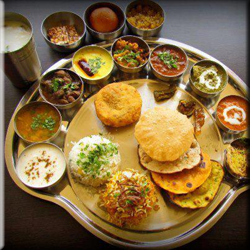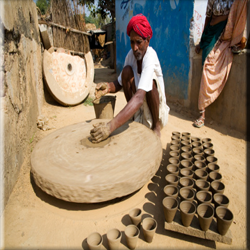CULTURE IS THE ART OF LIVING
The dominating population of Rajasthan are the Rajputs. The state is also popularly known as the 'Land Of Rajputs' which means the 'son of the king'. It is believed that the Rajputs are of Scythian origins who were originally the residents of Iran and Caucasia in central Europe. There are also other records which states that the Rajputs belong to the warrior clan or the descendants of the Ksatriyas of Vedic India. These Rajputs are classified into various castes and sub castes where the Gurjar Pratiharas are supposed to be the earliest of the Rajput clan.
The culture of Rajasthan can be best expressed as comprising the following : ORIGIN
Some of the other Rajput clan includes the Sisodias, Rathors, Chauhans, Kachawahas, Bhattis, Panwars and Solankis.The Rajputs are noted for their bravery who fought to protect their land from several Muslim invaders like Mohamed Ghori. The Rajputs are brave warriors and excellent rulers and administrators.Atleast 12% of the total population of Rajasthan is constituted by the tribal people. Some of the major tribes of Rajasthan are the Bhils, Minas, Lohars, Garasias and Sahariyas. Udaipur is mainly occupied by the Bhils tribal community and districts like Jaipur and Madhopur are inhabited by the Minas.Garasias and Sahrias tribes belong to the Sirohi and Kota district. The lohars are nomads who found their home in Udaipur. The Sahariyas inhabit the jungles of Shahbad, Jhalawar, Sawai Madhopur, Dungarpur and Udaipur. CULTURE
The Rajasthani's own the pride of not only enriching the culture of Rajasthan but also the entire culture of India. The people of Rajasthan are known for their culture which is nearly 5000 years old and which is a blend of tradition and history with the present contemporary lifestyle. There are lot of customs and traditions followed by the diverse population of the state and it adds to the embellishment of the culture of the people. The cultural heritage of the Rajasthani's are influenced by various features like its folk music and dances, different languages and dialects, the majestic forts, palaces, mansions and divinely holy places of religious worship, its multihued fairs and festivals and its cuisine. Not only the people but also the commercial markets give a picture of the vibrant culture of the Rajasthani's. Various products of the people of Rajasthan which can reflect the culture of the state are tie and die textiles, intricately carved wooden furniture with alluring motifs, block print textiles, lavish Bandhej saris and kurtis, zari and embroidered saris, luxurious and royal hand knotted carpets and durries, astonishing blue pottery, captivating mojaris and jutis, and so on. TRADITIONS
The customs and traditions followed by the people of Rajasthan are those that pertain to that of the Vedic rites and rituals. The people of Rajasthan very strictly adhere to these traditional customs which is very essential according to every man and woman of Rajasthan. Each and every custom and rituals from birth to death according to the Vedas is followed by the people with just slight variations based on their region and the numerous sub castes. These ceremonies which have to be done as a part of their customs are known as Samskaras which depict the three stages of life namely birth, marriage and death. There are nearly sixteen Samskaras. At the time of a girl's pregnancy charms are tied around the neck and waist and also to prevent the evil eye falling on her, a knife is put under her pillow every night and is not allowed to go under certain specific tree where the Rajasthani's believe that spirits reside on those trees. The girl who is pregnant for the first time has to come to her parents well in advance. Festivities start and women assemble to sing songs specially meant for such an occasion, some describing the changing behavior and liking of a pregnant woman. COSTUMES
The Rajasthani men's style of dressing is very classical and is quite different. The turbans form the most traditional part of dressing of the male which differs according to the various regions the people belong to. The turban is commonly known as Pagri and these Pagris are known as Jodhpuri Safa and Jaipuriya Pagris.The Angarakha which can be said as the Protector of body which is normally made up by the cotton textile. The most common form of the Angarakha costume is the kamari angarakha which isa frock type and goes upto waist length. The men also wear Dhoti or pyjama. The traditional costume of the women of Rajasthan is mostly a long skirt with a narrow waist that looks like an umbrella at the base. These skirts along with the top are called as Ghaghara which comes in vibrant colors. Usually the length of the skirt stops much before the ankle so that the accessory worn in the leg is visible. These skirts and dupattas are dyed or printed with mothras and lehariya print. Jaipur the capital state is very famous across the globe for its jewelry. The ornaments worn by the women are either gold or silver studded with diamonds, emeralds and rubies. They have a liking for chunky silver ornaments and lac ornaments. CUISINE

OCCUPATION

FAMOUS PERSONALITIES
Bhairon Singh Shekhawat -former Vice-President of India. He served as the Chief Minister of Rajasthan state three times, from 1977 to 1980, 1990 to 1992, and 1993 to 1998.
Jagjit Singh - famous ghazal singer from India.Recipient of Padma Bhushan, one of India's highest civilian honours, from the Government of India.
Maharaja Sawai Jai Singh - ruler of the kingdom of Amber (later called Jaipur).Jai Singh's greatest achievement was the construction of Jaipur city known as pink city.
Prithvi Raj Chauhan - second last Hindu king to sit upon the throne of Delhi.
Rajyavardhan Singh Rathore - Indian shooter.He is a recipient of the Padma Shri, a civilian award from the Government of India.


